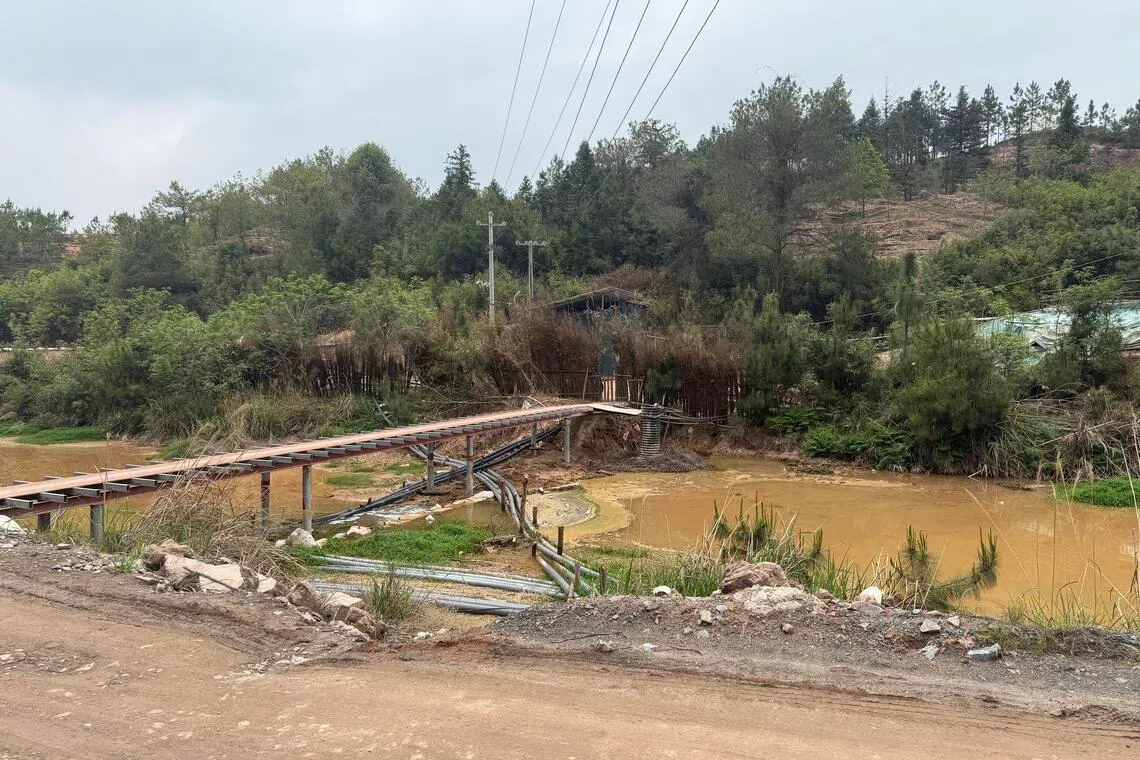Japan has boundless supply of rare earths that can blunt China’s dominance but are costly to mine
Sign up now: Get insights on Asia's fast-moving developments

A mine for heavy rare earth metals outside Longnan in south-central China's Jiangxi province.
PHOTO: KEITH BRADSHER/NYTIMES
Follow topic:
- Japan has discovered vast, "semi-infinite" rare earth deposits off Minamitorishima, potentially reducing reliance on China's near-monopoly.
- Mining these deep-sea reserves is costly and technically challenging, with exploratory mining planned for 2026 and supply by 2028.
- Japan is diversifying its rare earth sources and reducing reliance on China, urging international cooperation to counter Chinese export controls.
AI generated
TOKYO – Deep beneath the waters off Japan’s easternmost island of Minamitorishima lies what scientists have described as a “semi-infinite” trove of rare earths that can last the world for centuries.
With vast deposits of 16 million tonnes of high-quality rare earths, the world’s third-largest reserve can significantly cut into China’s dominance.
The snag is that they are costly and difficult to mine because of the deep depths of the sea – expected to be up to 6,000m below the ocean surface – around Minamitorishima.
China, which holds a near-monopoly in the processing of these critical minerals, has used trade restrictions and export controls
Rare earths refer to 17 metallic elements that are needed to manufacture everything from electric vehicles (EVs), aircraft engines and wind turbines to medical lasers, semiconductors and military weapons systems. They are classified by atomic weight as “light”, “medium” or “heavy” and, generally, they are more valuable the heavier they are.
In April, China imposed export curbs on seven types of heavy and medium rare earths that are sourced almost entirely from within the country, including dysprosium and terbium that are used widely in EVs.
On Oct 9, Beijing imposed sweeping new restrictions
US Trade Representative Jamieson Greer has described the move as a “global supply-chain power grab”, while Treasury Secretary Scott Bessent told Fox Business that China has “pointed a bazooka at the supply chains and the industrial base of the entire free world”.
US President Donald Trump reacted by threatening to impose an additional 100 per cent tariff
But scientists have noted that the mineral deposits in waters around Minamitorishima, a remote atoll nearly 2,000km south-east of Tokyo in the north-western Pacific, contain far higher concentrations of heavy and medium rare earths than in China.
Japan is getting ready to plumb into the seabed, with exploratory small-scale mining to begin in January 2026. Supply to the private sector is targeted for 2028.
The huge reserves, discovered in 2013, were described by Japanese scientists in a 2018 research paper as having “the potential to supply metals on a semi-infinite basis to the world” for between 420 and 780 years, depending on the type of element.
Japan recognises the importance of economic security, but is concurrently aware of the technical challenges of mining at depths of up to 6,000m below sea level. Doing so at scale would be a world-first, and will be an extremely costly endeavour.
In contrast, China’s rare earth reserves are located onshore, and thus are more accessible and much cheaper to mine.
What this means, experts told The Straits Times, is that the deposits off Minamitorishima will have no immediate impact on China’s dominance but could be a medium-to-long-term solution, provided there are technological advancements that make mining them commercially viable.
“Each voyage, involving world-first deep-sea mining technology, is expected to cost more than 150 million yen (S$1.3 million),” Nomura Research Institute executive economist Takahide Kiuchi told ST.
“This makes it far more expensive than Chinese materials. It’s unclear whether the project would be commercially viable, or if the exploratory voyage will even go to plan,” he said.
Dr Kazuto Suzuki, an expert on economic security at The University of Tokyo’s Graduate School of Public Policy, added that new refineries would need to be built to process the extracted minerals from around Minamitorishima.
“Changes in rare earth prices or government support could make them a viable resource, but such possibilities remain small at present,” he said.
What this means is that it would be impossible to cut China out of supply chains, Dr Suzuki said, even if Japan has already been taking measures to reduce its reliance on its neighbour.
In this regard, Japan offers lessons for the rest of the world.
In 2010, China curbed its rare earth exports to Japan in retaliation against the latter’s arrest of the captain of a Chinese fishing boat that had collided with a Japanese Coast Guard patrol vessel off the disputed Senkaku/Diaoyu islets.
This restriction was a huge blow to Japan because it depended on China for 90 per cent of its rare earths needs.
To reduce this reliance, it began cooperating with resource-rich countries such as Australia, India and Kazakhstan, while also investing in new refineries in Malaysia and Vietnam to bypass China. It now relies on China for just under 60 per cent of its rare earth requirements.
“However, the minerals minable in Australia are only light rare earths. China holds larger reserves of medium and heavy rare earths,” Dr Suzuki said.
“The current difficulty is that even if (the minerals are) mined elsewhere, the refining process is concentrated in China, making it impossible to completely sever all dependence on China,” he added.
To further reduce its dependence on China, noted Mr Kiuchi, Japan has prioritised the research and development of magnets and materials that do not use rare earths, acted to grow its national strategic stockpiles of the minerals, and built technology to retrieve and recycle them from used products.
Still, these steps are not yet enough by Tokyo’s reckoning, especially since it remains vulnerable to Chinese export restrictions. For example, China’s rare earth controls in April had forced carmakers Nissan and Suzuki to briefly halt their production lines.
These longstanding economic security concerns mean Japan has been working with other countries and regions, including the US, France, India and Africa, to forge alternative rare earth supply chains.
It has also condemned China’s latest round of curbs, which Beijing has defended as legitimate and in accordance with international law.
Foreign Minister Takeshi Iwaya told reporters on Oct 14: “We have been making requests to China at various levels, including through Chinese Foreign Minister Wang Yi, to ensure that global supply chains will not be affected further by its export controls.”
Finance Minister Katsunobu Kato, in Washington for a meeting with counterparts from the Group of Seven (G-7) bloc of advanced economies, said on Oct 16 that the group “must work together and respond strongly against China”.
Mr Kiuchi noted, however, that the fact of the matter is that China wields a potent diplomatic lever.
“China’s rare earth export restrictions are not just targeted at the US, but are aimed at sending a message to other democracies that are cooperating with the US on China policy,” he said.


